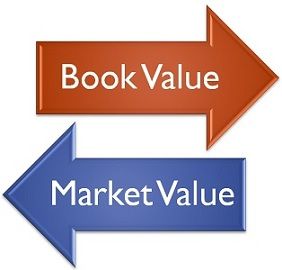This helps in assessing whether or not a stock’s present worth displays its intrinsic worth, thereby decreasing funding threat. This process entails a deep dive into various metrics and valuation methods to discover out the potential return on funding (ROI). By understanding both market and guide values, traders could make more informed selections about the place to allocate their capital. Differences between guide worth and market worth come up from elements similar to market notion, future growth potential, intangible property, inflation, and investor sentiment. A profitable firm is prone to have the next market worth because of positive investor sentiment and expectations of continued earnings.
Like I mentioned within the first group of bullet points on this article, accounting requirements require property to be recorded at price. Trying at the debt side, meaning determining how a lot new capital would price (in the form of an interest rate). How expensive debt was to raise for the company prior to now can be helpful in figuring out additional issuances IF the corporate has an identical danger profile/liquidity/financial power. Nonetheless, the whole point of calculating WACC is to estimate how much a company can raise in capital so as to fund new investments and future growth. This means your asset would promote for less than the worth you initially paid for it minus depreciation. Hold in thoughts that the market worth of an asset could change for higher or worse during the course of its helpful life.
- Investors must therefore think about whether or not market optimism or pessimism influences discrepancies.
- Book value, derived from a company’s monetary statements, reflects the web asset value based mostly on historical costs and accounting principles.
- This means your asset would sell for lower than the price you originally paid for it minus depreciation.
- Its BV reflects its computer systems and office furnishings, while its MV displays the billions in future profit these property are anticipated to generate.
- It provides a tangible measure of an organization’s internet worth and can be used to evaluate its monetary stability.
This scenario often signifies that the market could be overlooking the company’s tangible property, or there could possibly be pessimistic perceptions about its future prospects. For value investors, this scenario may present a possibility to buy into essentially sound companies at a reduction. Nevertheless, it’s crucial to conduct additional analysis to make sure the low market value isn’t because of underlying issues corresponding to administration issues or trade challenges. Both book and market values provide meaningful insights right into a company’s valuation. Comparing the two might help investors determine if a stock is overvalued or undervalued, given its assets, liabilities, and talent to generate revenue.
What’s Market Value?
In simple phrases, BV is what’s left over for shareholders in any case debts are paid off. It’s calculated primarily based on the historical price of belongings (what the corporate initially paid for them), adjusted for depreciation. The worth per book worth is a means of measuring the value supplied by a firm’s shares. It is feasible to get the worth per book value by dividing the market value of a company’s shares by its guide value per share. It implies that investors can recover more cash if the company goes out of enterprise.

When that happens, it normally signifies that the market has momentarily lost confidence in the company. It could additionally be because of enterprise problems, lack of important lawsuits, or different random occasions. In different words, the market doesn’t consider that the company is definitely value the worth on its books.

The main distinction between book and market value lies in their foundational ideas. E-book value displays the net price of a company’s tangible property as recorded in its monetary statements, offering a historic account of worth. Conversely, market worth represents the current value decided by investor perception and market dynamics. Asset valuation in finance includes determining the honest market worth of belongings such as shares, bonds, actual property, or intellectual property. Techniques like discounted cash flow (DCF), comparable company evaluation, and asset-based approaches are generally used to estimate worth.

Understanding The Distinction Between Book And Market Value In Funding
Like the inventory market, where the value of shares is all the time altering, the market value of your assets and enterprise might be greater than what you paid at some point and lower the subsequent. You have to know the difference between guide worth vs. market worth to know the accurate value of your business and its property. Overall, differentiating between book and market value allows investors to undertake a disciplined, knowledgeable strategy, finally fostering extra profitable value investing outcomes. The time period book worth vs market value compares a business’s financial value on paper to how much it’s value in the real world. Returning to our previous examples, Microsoft had a market value of roughly $1,540.6 billion, far exceeding its book worth of $118 billion.

Book value can be greater than market worth when a company’s property are overvalued on the balance sheet or when market conditions reflect decrease investor confidence. Having a excessive market value doesn’t at all times imply an organization’s shares characterize a great funding. It is essential to judge other measures of a company’s monetary health, in addition to its development prospects and the relevant competition. Buyers can use book value to discover out https://www.simple-accounting.org/ a company’s web asset worth per share (book value per share).
This evaluation can be notably valuable when you’re evaluating the stability and solidity of a company’s operations. For occasion, when contemplating whether or not to put money into a company’s inventory, the market value can give you insight into how a lot other investors are keen to pay for shares at the present second. On the other hand, helps assess if a company is undervalued or overvalued by comparing it with its book value. This comparability can be like checking whether or not a bit of actual property is priced fairly based on what related properties within the space have sold for just lately versus their historic cost to build.
Guide worth, derived from a company’s financial statements, reflects the net asset value based on historical costs and accounting principles. Conversely, market value is decided by investor perceptions, supply and demand, and market sentiment, often diverging significantly from e-book value. Guide worth represents the web asset worth of a company as recorded on its balance sheet, calculated by subtracting total liabilities from complete assets.
